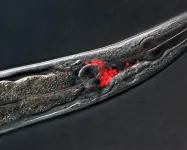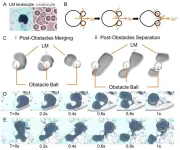(Press-News.org)
A study of nematodes by researchers at Nagoya University in Japan has found that aging-related decline in brain function is caused by the excessive activation of certain neurons over time, rather than a decline in neuronal activity. This finding, published in the journal Proceedings of the National Academy of Sciences, suggests that interventions aimed at reducing neuronal hyperactivation, such as dietary changes, could potentially mitigate age-related cognitive decline.
Proper brain function occurs when a large number of neurons are connected to each other and work in an appropriate way. In this sense, declines in brain function with age have generally been attributed to a decrease in the activity of neurons over time.
However, in humans, some types of neurons have been reported to become hyperactive with age. A research group led by Associate Professor Kentaro Noma of Nagoya University conducted experiments on nematodes to determine the cause-and-effect relations between the hyperactivation of neurons and the decline in brain function with age.
"In this study, we used the nematode Caenorhabditis elegans, which is only one millimeter long and has a lifespan of only two weeks. The nematodes exhibit a variety of behaviors with their 302 neurons," Noma said. "C. elegans shares many genes and mechanisms with humans. So, we thought that the cause of the decline in brain function over time in C. elegans may apply to humans."
This study took advantage of the ability of C. elegans to learn by association in a behavior called thermotaxis. In this behavior, C. elegans kept in an environment with food at 23 degrees Celsius will move toward 23 degrees when placed in an environment with a temperature gradient from 17 to 23 degrees. However, the animals will choose not to do so if kept in an environment where there is no food. This suggests that C. elegans learns to associate the presence or absence of food with the temperature of their environment.
"Our previous studies found that the brain function for associative learning in C. elegans declines over time, and we thought this was due to a decline in neuronal activity with age," said Binta Maria Aleogho, first author of the study. "In our latest study, however, we found that the activities of AFD sensory neurons and AIY interneurons, both of which are thought to be essential for associative learning, have barely changed with age."
The researchers then studied the behavior of C. elegans when each of six types of neurons thought to be involved in associative learning—the sensory neurons AWC and ASI, and the interneurons AIZ, AIB, RIA, and AIA—was removed from the brains of nematodes. Surprisingly, after removing AWC or AIA from their brains, the nematodes could move to the 23-degree location.
The researchers also measured the activities of the neurons in aged nematodes. They found that AWC and AIA are spontaneously and excessively activated with age. "This finding suggests that the hyperactivation of these two types of neurons with age disrupts the normal neuronal network, rendering them unable to carry out the thermotaxis behavior," Noma said.
"In addition, we were able to suppress neuronal hyperactivation and prevent behavioral decline in aged nematodes by changing the type of bacteria as their food source. So, we humans might be able to prevent the aging of our brains by changing our diet."
He concluded: "So far, we have tended to focus on the decline in neuronal activity with age. Our findings may lead people to focus on the hyperactivation of neurons. We will continue to study C. elegans to determine how to reduce the hyperactivation of neurons to improve brain function. We believe this will help us understand the basis of aging in brain function."
END
Osaka, Japan – From disaster zones to extreme environments, there remain areas difficult for even humans to reliably access. This poses a problem for search-and-rescue operations, research, surveillance, and more. Now, however, a research team from Osaka University and Diponegoro University, Indonesia is hard at work on one potential solution: the cyborg insect.
Cyborg insects have a lot of advantages over traditional robots. Power consumption is less of an issue, so it’s easier to miniaturize them, and they are even ‘pre-built’ in a sense. However, research on cyborg insects has been limited to simple environments, like flat surfaces supplemented ...
New research from the University of Sydney has found people tend to discriminate in favour of individuals who show a similarity to them, even when the similarity arises from a random event like the flip of a coin.
Published in Proceedings of the National Academy of Sciences, the research runs counter to traditional theories, in particular social identity theory, that assume discrimination occurs because we divide people into groups. It finds, instead, differences between individuals are enough to trigger discrimination.
Previous research (using the seminal ‘minimal group’ experiment) showed participants tend to financially benefit members of their own group over ...
As solar energy plays an increasing role in the global power supply, ensuring accurate forecasts of photovoltaic (PV) power generation is critical for balancing energy demand and supply. A new study published in Advances in Atmospheric Sciences explores how machine learning and statistical techniques can refine these forecasts by correcting errors in weather models.
Weather forecasts are a key input for PV power prediction models, yet they often contain systematic errors that impact accuracy. Researchers from the Institute of Statistics at the Karlsruhe Institute of Technology ...
Scientists led by Prof. LIU Jing from the Technical Institute of Physics and Chemistry of the Chinese Academy of Sciences (CAS) have created a leukocyte-like liquid metallic entity that vividly simulates various leukocyte behaviors in nature.
Published in Matter on February 10, the researchers demonstrated how these "liquid metallic leukocytes" can autonomously perform complex actions like engulfing foreign substances, changing shape, moving in a pulsatile manner, and even climbing against gravity—showing striking similarities to the dynamic behavior of living cells.
The research ...
RICHLAND, Wash.—Curled up inside every single one of the trillions of cells in the human body is six feet of DNA, spooled tightly and carrying the genetic instructions that govern so much of who a person becomes. It’s a nicely wrapped package of instructions for a lifetime.
But having the package in hand is a far cry from understanding how it’s executed.
It’s been 20 years since scientists completed the Human Genome Project, sequencing the entire length of DNA found in a person. Scientists have now done the same with an amazing array of organisms, including some types of worms, mice, mosquitoes, fruit flies, trees, rice and pufferfish.
Science ...
Researchers at Flinders University say there is an urgent need to encourage more girls to participate in sports, following a new study that reveals a striking lack of research on girls' sport engagement.
A new study in Sport in Society journal set out to review existing data on interventions to engage female adolescents in organised sport, and to explore the different factors that influence their experience and decision making in sport.
“Despite a rigorous systematic search of more than 3,000 articles, only five (globally) were found to ...
Certain hormonal contraceptives are associated with a higher stroke and heart attack risk, finds a large study from Denmark in The BMJ today that draws on prescription records to give more precise estimates for different products than previous studies.
The highest risk estimates were for oestrogen containing products, in particular the vaginal ring and skin patch.
The researchers stress that the absolute risk remains low, but given the widespread use of these products and the seriousness of these conditions, they say clinicians should consider these potential risks when prescribing them.
Almost 250 million women worldwide are estimated to use hormonal contraception. Previous ...
Australian researchers are designing a global real-time monitoring system to help save the world’s coral reefs from further decline, primarily due to bleaching caused by global warming.
Coral reefs worldwide are dying at an alarming rate, with 75% of reefs experiencing bleaching-level heat stress in the past two years.
The World Heritage-listed Great Barrier Reef (GBR), considered the jewel in the crown of coral reefs worldwide and one of Australia’s most significant ecological and tourism assets, has been decimated ...
A new study finds that training in critical thinking skills can be effective in counteracting conspiracy beliefs.
Many well-established programmes for reducing people's belief in conspiracies have either no effect or a negative effect.
The study is the first to directly compare different strategies to reduce conspiracy thinking.
A new experimental study has found that fostering critical thinking can be an effective method to reduce people's tendency to believe in conspiracy theories.
Led by researchers at University College Cork (UCC), the ...
Embargoed until 00:01 GMT on Thursday 13 February 2025
-With pictures-
Babies show positive responses to the smell of foods they were exposed to in the womb after they are born, according to a new study.
The findings, led by Durham University, UK, could have implications for understanding how healthy eating habits might be established in babies during pregnancy.
Researchers analysed the facial expressions of babies who had been repeatedly exposed to either kale or carrot in the womb after birth.
Newborns whose mothers had taken carrot powder capsules when pregnant were more likely to react favourably to the smell of carrot.
Likewise, ...







